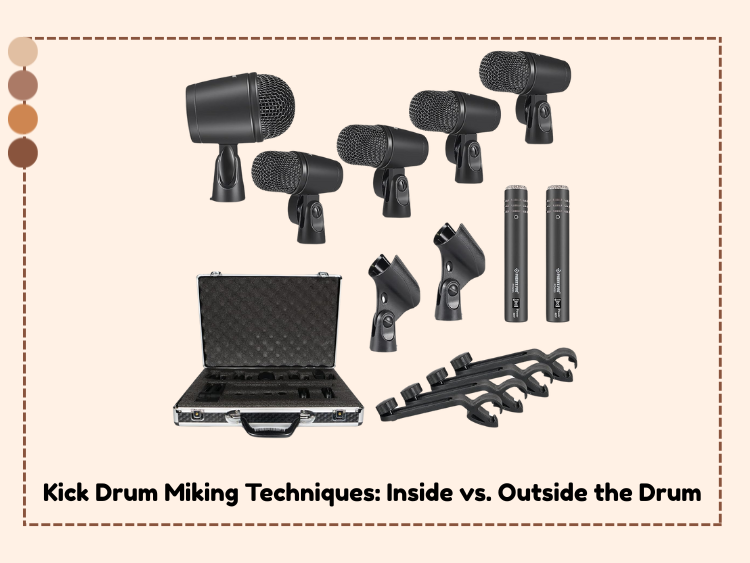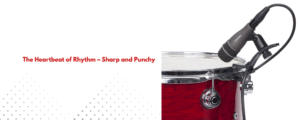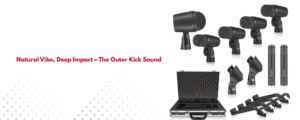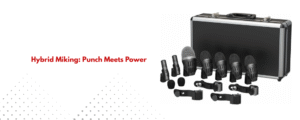When recording or mixing drums, the kick drum is very important. In live shows and studio records, that deep, punchy sound anchors the low end and drives the beat. It takes engineers a long time to figure out how to mic it right. Whether to put the mic inside or outside the kick drum is one of the most important choices. You can choose the best sound for your song, room, and general mix by knowing how the different options compare. We will talk about the pros and cons of each way and when it makes sense to use one over the other.
Inside the Kick Drum: Sharp, Concentrated, and Punchy
The Technique
You have to put a microphone inside the shell of a kick drum in order to record it. You can usually get to the microphone through a hole in the front (resonant) head or by taking off the front head. To get the best sound, people tilt the mic towards where the hitter hits the head and put it a few inches away.
The Sound
This is a very good way to record the sound of the beater hitting the drum. There is a strong “click” or “thwack” sound from the kick drum that makes it stand out in complex mixes. The sound is more focused and tight because it minimizes bleed from other drums and room ambience.
Pros:
- It has a better attack and is great for rock, metal, and pop music that needs a strong kick.
- Less bleed from drums and other instruments.
- It’s easier to shape the sound with EQ and compression because the information is dry and focused.
Cons:
- It doesn’t have as much low-end boom, so the natural weight and reverberation of the drum can be lost.
- Without room tone, the sound may not have enough volume or warmth.
- Accessing the inside might need a ported head or an open drum.
Well-known Microphones:
For a deeper understanding of how different mics impact drum recording, check out this comparison of dynamic vs. condenser microphones.
Outside the Kick Drum: Natural, Deep, and Spacious
The Way Forward
A microphone outside of the kick drum is usually placed right in front of the resonating head or a few inches away, based on the desired sound. This way records more of the drum’s natural low-frequency reaction and how it interacts with the room.
The Sound
The outside microphone makes the sound smoother and fuller. You’ll hear the inside of the room, the air going through the drum, and the sound of the shell. It sounds more natural and powerful, which makes it a great choice for styles that need a low-end that sounds natural.
Pros:
- Richer low-end: great for jazz, blues, and acoustic music.
- It gives the drum personality and a sense of space.
- It works well with completely closed drums, so you don’t need heads with ports.
Cons:
- It can sound softer and less defined when the beater attack is used.
- More Bleed: Other instruments can bleed into the mic when used live.
- Placement Sensitivity: Even small changes in position can greatly affect the sound and how it works with other microphones.
Well-known Microphones:
Want to explore how mic technology has evolved to make this kind of nuanced capture possible? Dive into the history of drum microphones to see how far we’ve come in capturing the perfect drum sound.
How to Use Both Inside and Outside Mics: The Hybrid Method
Why pick just one way if you want accuracy and a full sound?
An inside mic is often used for attack, and an outside mic is used for body and warmth. Using two microphones gives a fuller picture of the kick drum’s sound and gives you more mixing options.
How to Use Two Mics: Key Points
- Look at the phase alignment: If the mics are not phase-aligned, frequencies can cancel each other out, making the sound thin or hollow. Change the setting of one mic and its orientation until the sound is louder.
- EQ Smartly: Use EQ to bring out the best in each mic. For instance, low-pass the inside mic to smooth out high-end clicks and high-pass the outside mic to eliminate noise.
- Blend to your liking: The inside mic can add punch, and the outside mic can be added slightly to make the sound bigger and fuller.
Conclusion
Miking a kick drum involves experimentation and continual refinement of your technique. It’s important to know the pros and cons of inside and outside mic placement, whether you want the tight, intense punch of a modern rock record or the warm, natural thump of an old jazz kit. Don’t be afraid to try different things with placement, mic choice, and mixing. Trust your ears, and let the song lead the sound. And if you’re looking to improve your gear for optimal results, consider joining 5 Core’s Business Partnership Program to access premium audio equipment and exclusive discounts, helping you perfect your sound.




